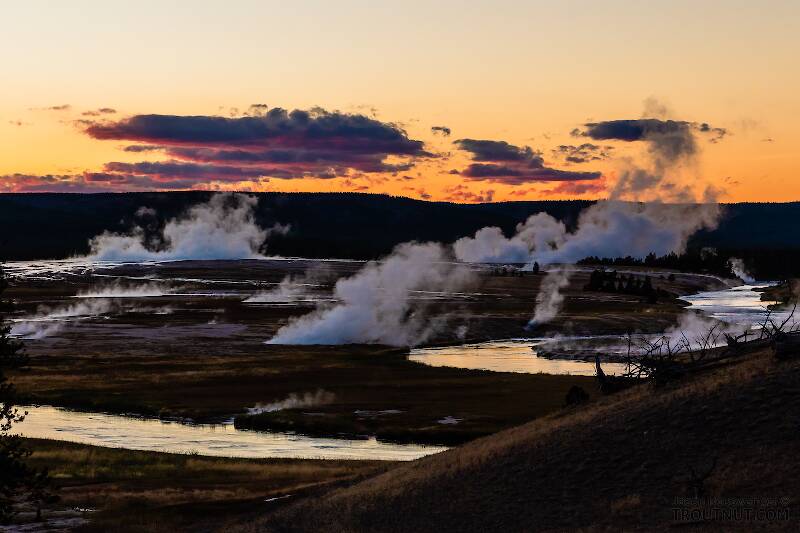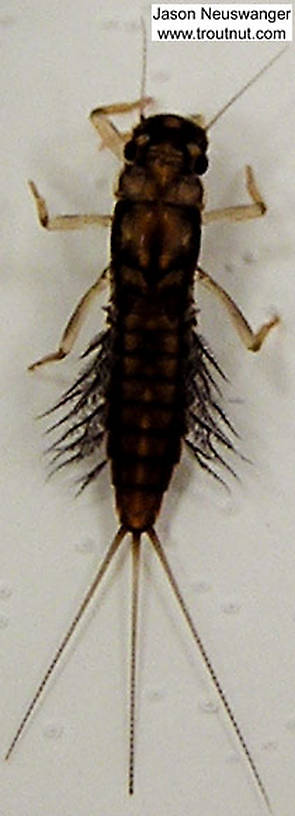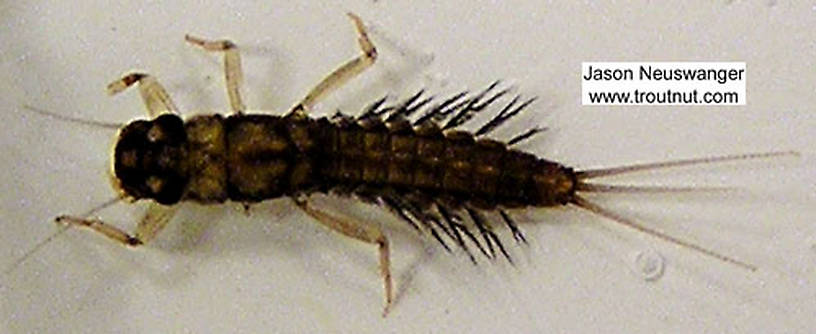
Blue-winged Olives
Baetis
Tiny Baetis mayflies are perhaps the most commonly encountered and imitated by anglers on all American trout streams due to their great abundance, widespread distribution, and trout-friendly emergence habits.
Featured on the forum

This specimen keys to the Epeorus albertae group of species. Of the five species in that group, the two known in Washington state are Epeorus albertae and Epeorus dulciana. Of the two, albertae has been collected in vastly more locations in Washington than dulciana, suggesting it is far more common. On that basis alone I'm tentatively putting this nymph in albertae, with the large caveat that there's no real information to rule out dulciana.

Troutnut is a project started in 2003 by salmonid ecologist Jason "Troutnut" Neuswanger to help anglers and
fly tyers unabashedly embrace the entomological side of the sport. Learn more about Troutnut or
support the project for an enhanced experience here.
This topic is about the Mayfly Genus Paraleptophlebia
There are many species in this genus of mayflies, and some of them produce excellent hatches. Commonly known as Blue Quills or Mahogany Duns, they include some of the first mayflies to hatch in the Spring and some of the last to finish in the Fall.In the East and Midwest, their small size (16 to 20, but mostly 18's) makes them difficult to match with old techniques. In the 1950s Ernest Schwiebert wrote in Matching the Hatch:
"The Paraleptophlebia hatches are the seasonal Waterloo of most anglers, for without fine tippets and tiny flies an empty basket is assured."
Fortunately, modern anglers with experience fishing hatches of tiny Baetis and Tricorythodes mayflies (and access to space-age tippet materials) are better prepared for eastern Paraleptophlebia. It's hard to make sense of so many species, but only one is very important and others can be considered in groups because they often hatch together:
- Paraleptophlebia adoptiva is by far the most important species of this genus in the two regions and is an early Spring emerger.
- Paraleptophlebia mollis, Paraleptophlebia guttata, and Paraleptophlebia strigula complement each other in late spring and early summer.
- Paraleptophlebia debilis and Paraleptophlebia praepedita occur together in the fall.
- The most important species is Paraleptophlebia debilis. This large (for the genus) Fall emerger can be found throughout the region. It is often accompanied by one of the slightly larger tusked species. Depending on locale, this can be Paraleptophlebia bicornuta (the most common), Paraleptophlebia packii or Paraleptophlebia helena. Check out their hatch pages for distribution information.
- Spring is the season for the smaller Paraleptophlebia heteronea throughout most of the region with Paraleptophlebia gregalis filling this niche in California and parts of Oregon.
Example specimens
Shawnny3 on Apr 6, 2009April 6th, 2009, 7:50 am EDT
I can't remember where I read or heard these things (might have been on this site), but I want to make sure my vague recollections are not totally false. When Paraleptophlebia are mating, do they make exaggerated dives in clouds above the stream? If so, do they often end up in the water at these times or do they fall as spinners much later? Finally, when they emerge, do they do so at the stream bottom and then swim to the surface as duns?
Thanks for any help,
Shawn
Thanks for any help,
Shawn
Jewelry-Quality Artistic Salmon Flies, by Shawn Davis
www.davisflydesigns.com
www.davisflydesigns.com
Taxon on Apr 6, 2009April 6th, 2009, 10:35 am EDT
Shawn-
Yes, but not necessarily above the stream.
Yes, that has been reported.
Immediately following mating, the female Paraleptophlebia spinner lands on the water in a wings up manner to release her eggs, and repeats this behavior several times before flying off to streamside vegetation.
No, they usually emerge at or in close proximity to the surface. However, their emergence is usually in close proximity to the stream edge, so it will often be in extremely shallow water.
I can't remember where I read or heard these things (might have been on this site), but I want to make sure my vague recollections are not totally false. When Paraleptophlebia are mating, do they make exaggerated dives in clouds above the stream?
Yes, but not necessarily above the stream.
If so, do they often end up in the water at these times(?)
Yes, that has been reported.
or do they fall as spinners much later?
Immediately following mating, the female Paraleptophlebia spinner lands on the water in a wings up manner to release her eggs, and repeats this behavior several times before flying off to streamside vegetation.
Finally, when they emerge, do they do so at the stream bottom and then swim to the surface as duns?
No, they usually emerge at or in close proximity to the surface. However, their emergence is usually in close proximity to the stream edge, so it will often be in extremely shallow water.
Lastchance on Apr 6, 2009April 6th, 2009, 12:23 pm EDT
So, are you saying that it's not much use trying to fish a blue quill hatch? Are nymphs lodged on the edge of the stream, too? I've tied blue quill nymphs and dries, but never had an opportunity to fish them. I've seen them darting erratically up and down in a cloud near the water, but I've never witnessed many fish rising to them. Is it the blue quills many people confuse with the darting tricos? I've always wondered about them. Educate me, please. I'm glad this topic was presented.
Thanks,
Bruce
Thanks,
Bruce
Taxon on Apr 6, 2009April 6th, 2009, 12:52 pm EDT
Bruce-
Not sure how you might have gotten that impression from anything I responded to Shawn, but that is certainly not the case. When trout are keyed to emerging Paraleptophlebia duns, they will take the duns in shallow water.
Don't know the answer to that question.
So, are you saying that it's not much use trying to fish a blue quill hatch?
Not sure how you might have gotten that impression from anything I responded to Shawn, but that is certainly not the case. When trout are keyed to emerging Paraleptophlebia duns, they will take the duns in shallow water.
Is it the blue quills many people confuse with the darting tricos?
Don't know the answer to that question.
Martinlf on Apr 6, 2009April 6th, 2009, 2:23 pm EDT
Yes, people do often mistake BQ spinners for Tricos. I was told that the BQ spinners have a greater up and down motion, while the Tricos move more side to side, and I have verified that behavior.
I was also told that the BQ spinners don't fall on the water, and that is why some often wait in vain for the spinner fall. Taxon seems to verify this when he says the females fly off to streamside vegetation after egglaying. On the other hand, I believe I've heard some say they have caught fish on BQ spinners, suggesting a spinner fall on the water. Perhaps this varies with different species.
As for fishing the duns, I know the early BQ's, adoptiva, are a strong hatch in the spring on some waters such as Fishing Creek near Lamar PA. It's the summer BQ's that (logically, of course) get confused with Tricos. Long ago, looking for Tricos, I once waited and waited for the darn things to spend and fall to the water--but in vain. No fish rose to them. I know some who catch fish on the summer duns, though.
I was also told that the BQ spinners don't fall on the water, and that is why some often wait in vain for the spinner fall. Taxon seems to verify this when he says the females fly off to streamside vegetation after egglaying. On the other hand, I believe I've heard some say they have caught fish on BQ spinners, suggesting a spinner fall on the water. Perhaps this varies with different species.
As for fishing the duns, I know the early BQ's, adoptiva, are a strong hatch in the spring on some waters such as Fishing Creek near Lamar PA. It's the summer BQ's that (logically, of course) get confused with Tricos. Long ago, looking for Tricos, I once waited and waited for the darn things to spend and fall to the water--but in vain. No fish rose to them. I know some who catch fish on the summer duns, though.
"He spread them a yard and a half. 'And every one that got away is this big.'"
--Fred Chappell
--Fred Chappell
LittleJ on Apr 6, 2009April 6th, 2009, 4:49 pm EDT
This sounds like a good situation to fish a Little Black Caddis (AKA stonefly this time of year) With a bead head paralep dead drift just below the surface film. I would think that the shallow water emergence would actually make this hatch more attractive, given that this time of year we are often fighting high water levels and the shallow eddies may be our best bet anyway.
This post got me thinking, and the last time I was out, I do believe most of the fish I caught on my little black biot nymph, were on the far seams close to the bank. However I think this theory needs some more field work. If anyone is available to work for me this week let me know, I think i should take one for the team and run some extensive field tests on fishing creek. I hate to do it but......it's in the name of science.
jeff
This post got me thinking, and the last time I was out, I do believe most of the fish I caught on my little black biot nymph, were on the far seams close to the bank. However I think this theory needs some more field work. If anyone is available to work for me this week let me know, I think i should take one for the team and run some extensive field tests on fishing creek. I hate to do it but......it's in the name of science.
jeff
Konchu on Apr 7, 2009April 7th, 2009, 5:10 am EDT
most of the paraleptophlebia species I have worked with locally emerge at the surface of the slower water near the stream bank, but I don't think this holds for all of them. the spinners that I have watched were swarming over some object in the stream (a swarm marker) around mid-day. I've found some females with eggs still in them on the surface, near death.
what times of day have others seen the spinners in flight?
what times of day have others seen the spinners in flight?
Shawnny3 on Apr 7, 2009April 7th, 2009, 9:42 am EDT
Nice responses. Thanks to all.
-Shawn
-Shawn
Jewelry-Quality Artistic Salmon Flies, by Shawn Davis
www.davisflydesigns.com
www.davisflydesigns.com
Hannah101
Posts: 1
Posts: 1
Hannah101 on Apr 29, 2009April 29th, 2009, 7:56 pm EDT
what are some other adaptations for a mayfly phsiological, physical and behavioural?
Taxon on Apr 29, 2009April 29th, 2009, 10:48 pm EDT
Hannah101-
Please don't be offended, but it seems like, if you are able to pose a question as sophisticated as that, you must already know much of the answer.
Please don't be offended, but it seems like, if you are able to pose a question as sophisticated as that, you must already know much of the answer.
Quick Reply
Related Discussions
Topic
Replies
Last Reply
4
Dec 22, 2009
by Oldredbarn
by Oldredbarn
2
Jul 9, 2018
by Martinlf
by Martinlf
7
Mar 13, 2007
by Troutnut
by Troutnut
17
Apr 10, 2012
by Entoman
by Entoman







